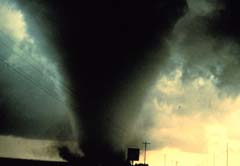| NOAA Magazine || NOAA Home Page |
MOBILE HOMES AND VEHICLES DEADLY IN TORNADOES
 March
5, 2003 — Now that spring is here—meteorologically speaking—NOAA
reminds Americans to be prepared for tornadoes.
Tornadoes occur most often in March through early July, but they can and
do occur throughout the year. The number of tornado deaths in mobile homes
increased significantly in 2002, totaling more than half of all tornado
deaths in the United States, according NOAA. (Click NOAA image
for larger view of tornado south of Dimmitt, Texas, taken June 2, 1995.
Please credit “NOAA.”)
March
5, 2003 — Now that spring is here—meteorologically speaking—NOAA
reminds Americans to be prepared for tornadoes.
Tornadoes occur most often in March through early July, but they can and
do occur throughout the year. The number of tornado deaths in mobile homes
increased significantly in 2002, totaling more than half of all tornado
deaths in the United States, according NOAA. (Click NOAA image
for larger view of tornado south of Dimmitt, Texas, taken June 2, 1995.
Please credit “NOAA.”)
In 2002, a total of 55 people died in tornadoes, 37 of whom were in mobile homes, 12 in permanent homes, four in cars and two outside. In 2001, 40 fatalities were recorded, 11 of those in mobile homes, 18 in permanent homes, six in vehicles, three outside and two in buildings. In 2000, 29 of the 40 tornado deaths, or nearly 78 percent, were in mobile homes, four were in permanent homes, four in vehicles, one was outside and two were in buildings.
One reason for the growing rate of mobile home deaths is the increased population in such homes in the past 30 years, according to Harold Brooks, research meteorologist with the NOAA National Severe Storms Laboratory. The number of mobile homes per capita has grown the most in the Southeast, from Arkansas eastward, except for Florida, which has seen slower growth in mobile homes because of new higher building standards in the aftermath of Hurricane Andrew.
Mobile homes are not safe during tornadoes. The NOAA National Weather Service recommends leaving a mobile home and going to the lowest floor of a sturdy nearby building or storm shelter.
“Tornadoes are extremely violent and other than underground there is no good place in a tornado,” said Dan McCarthy, warning coordination meteorologist with the NOAA Storm Prediction Center. “If you can’t get underground, the best place is in the center of a permanent structure.”
The NOAA National Weather Service’s aim, he said, is to make sure no one finds themselves in the middle of nowhere with a tornado bearing down on them. However, in that situation, the NOAA National Weather Service recommends abandoning vehicles when a tornado is approaching, and not take cover underneath overpasses.
“Vehicles may not be appropriate shelter. We can provide numerous documented cases of vehicles being carried aloft and dropped by tornadoes, and vehicles impaled by flying debris such as 2x4s,” McCarthy said. “We realize when lying in a ditch you are also vulnerable to flying debris, but it may be better to get out of and away from the vehicle and taking cover by placing your hands over your head.”
Then NOAA National Weather Service’s safety recommendations were made following a thorough study conducted by Centers for Disease Control epidemiologists in 1979 following the deadly Wichita Falls, Texas, tornado. They found that people in vehicles trying to escape tornadoes became stuck in traffic jams and on dead-end streets. Others were killed when the tornado curved back over them after they thought they had driven to a safe place. The CDC recommended at that time people in motor vehicles should seek shelter immediately upon hearing a tornado warning and should not attempt to drive from the tornado’s path.
“Ultimately, it’s up to each person to decide what to do based on their circumstances,” McCarthy said. “Each situation is different, so making an informed decision provides the best chance for survival.”
An average of 1,200 tornadoes cause more than $400 million in damage to homes and businesses, schools and churches annually. Considered nature’s most violent storms, peak tornado activity occurs during the months of March through early July. The NOAA National Weather Service, Red Cross, and the Federal Emergency Management Agency recommend the following actions if a tornado warning is issued.
- In a home or building, move to a pre-designated shelter, such as a basement or interior room or hallway on the lowest floor and away from windows.
- In a mobile home, even if tied down, seek shelter in a sturdy building. As a last resort, and if no sturdy building is available leave the mobile home and seek shelter in a nearby ditch. Do not stay in the mobile home.
- If caught outside or in a vehicle, and where no sturdy building is available lie flat in a nearby ditch away from overpasses and vehicles.
NOAA measures
spring from March 1 through May 31.
NOAA is dedicated to enhancing economic
security and national safety through the prediction and research of weather
and climate-related events and providing environmental stewardship of
the nation’s coastal and marine resources. NOAA is part of the U.
S. Department of Commerce.
Relevant
Web Sites
NOAA Storm Prediction
Center—The Basics about Tornadoes
NOAA's Monthly Tornado Statistics
NOAA National Severe Storms Laboratory
Media
Contact:
Keli
Tarp, NOAA Weather
Partners , (405) 366-0451